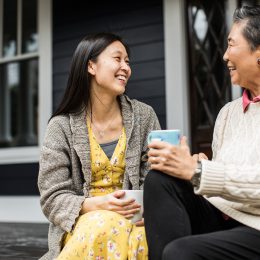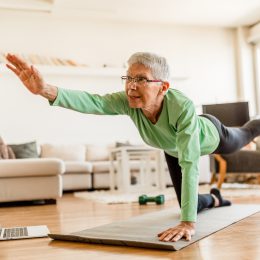6 Sun Safety Dos and Don’ts for Older Adults
No matter your age, the right sun protection can help minimize your risk for skin cancer. Follow these sun protection tips to keep your skin healthy.

Your baby-oil-at-the-beach days are behind you. But you may still need to step up your sun protection game.
Skin cancer is one of the most preventable forms of cancer. Yet only half of older adults protect their skin from the sun when outside on a nice day, according to the Centers for Disease Control and Prevention.
“I hear so often that the damage is already done, but the damage from sun exposure throughout one’s life is cumulative,” says Elizabeth Hale, M.D., senior vice president of the Skin Cancer Foundation. “That’s important because it means that it’s never too late to practice sun protective habits.”
Even if you’re 65 and have never been diligent about sunscreen before, you can — and should — start now. After all, adults at age 65 can expect to live another two decades, according to the CDC. That’s a lot of afternoons spent gardening, playing with grandkids in the yard, and beach days.
While having fun in the sun, follow these sun protection dos and don’ts to keep your skin healthy.
Add SilverSneakers to your wellness routine! Classes and events are happening right now at participating gyms, online through SilverSneakers LIVE, and at community centers near you. Activate your free online account to get started.
Do: Pick the Right SPF
As we get older and have more leisure time, many of us will naturally spend more time outdoors, says Dr. Hale. That might be on the golf course, on the pickleball court, or taking walks around your neighborhood.
To keep your skin safe, apply a broad-spectrum SPF 30+ sunscreen daily. And if you’re spending a long time outside, remember to reapply every two hours.
Today, there are newer formulations of sunscreen that make reapplying easier, says Dr. Hale. Use a sunscreen lotion or cream as your base coat. When reapplying, however, you can use a sunscreen spray for your body. For your face, use a brush-on powder or SPF facial setting spray, she advises. The latter two can also be applied right over makeup.
For more sunscreen specifics, check out our guide to choosing the right sunscreen here.
Don’t: Forget Other Sun Protective Measures
Sunscreen shouldn’t be the only tool in your arsenal to help protect against sun damage. Yet only 15% of older adults employ all five types of sun protection, according to the CDC.
In addition to using sunscreen, you can also protect your skin by:
- Seeking out shade
- Wearing a wide-brimmed hat to protect your face, ears, and neck
- Wearing a lightweight, long-sleeved shirt to cover your arms, shoulders, and upper back
- Wearing pants to cover your legs
Recommended reading: 8 Top Questions About Skin Cancer, Answered
Do: Use Skincare Products That Correct Damage
Sunscreen helps prevent sun damage. But what about the damage that’s already been done?
Dr. Hale recommends using products that contain DNA-repairing enzymes. (One example is an ingredient called photolyase.) These are commonly found in some sunscreens and moisturizers. “I’m a big fan of these products, as they can prevent and reverse some UV damage,” she says.
There are also damage-correcting procedures you can discuss with your dermatologist. Those include Fraxel, a laser treatment, as well as photodynamic therapy, which uses light-activated medication. Both procedures can remove precancerous skin cells, says Dr. Hale.
Don’t: Skip Your Annual Skin Check
Dermatologists recommend getting an annual skin exam, says Dr. Hale. There, your dermatologist will do a full-body check—even looking at your scalp and between your toes—to check for suspicious spots. If you have a personal or family history of melanoma, your dermatologist may recommend you have skin cancer screenings more frequently.
To prepare for your appointment, the Skin Cancer Foundation recommends:
- Removing makeup and nail polish
- Wearing your hair loose
- Being prepared to point out anything you’re worried about
If you notice a change in a mole (or a new one) before you’re due for your annual skin check, don’t wait. Call your dermatologist right away to schedule an appointment, Dr. Hale advises.
If you don’t have a dermatologist, there are dermatologists around the United States offering free skin cancer screenings. You can click on your state to see if there’s one in your area at AAD.org.
Do: Quit Smoking
Smoking cigarettes can harm nearly every part of your body, and your skin is no exception.
Rates of melanoma, a deadly form of skin cancer, steadily rise in adults between ages 65 and 84, according to the CDC. Smoking may impact your immune system’s ability to fight off melanoma cancer, increasing mortality from the disease, according to a study in Cancer Research.
Subscribe to our newsletter
It's quick and easy. You could be one of the 13 million people who are eligible.
Already a member? Click to discover our 15,000+ participating locations.
Follow Us
Quitting smoking is not easy, but there is support out there. One simple move you can make today is to call the CDC’s quitline, 1-800-QUIT-NOW.
Don’t: Use Tanning Beds
Younger adults are more likely to use a tanning bed compared to older adults. But the fact remains that no matter your age, indoor tanning beds are not safer than the sun, according to the American Academy of Dermatology (AAD).
These tanning beds are equipped with ultraviolet (UV) lights that deliver a concentrated source of damaging UV exposure to the skin. Plus, you’re often wearing very little clothing during a tanning session. Using a tanning bed increases your risk of developing squamous and basal cell carcinomas by 58 and 24 percent, respectively, according to the AAD. These are the two most common types of skin cancer.
Used a tanning bed when you were younger? You can’t do anything about your past, but you can monitor your skin now. If you see any new, dark, changing, or irregular spot on your skin (even on places where the sun don’t shine), get it checked out by a dermatologist.
The bottom line: By wearing the right sun protection, keeping up with skin checks, and following these simple measures, you’ll be well on your way to having healthy skin for life.
See our sources:
Older adult sun safety: Centers for Disease Control and Prevention
Link between smoking and melanoma mortality rates: Cancer Research
Indoor tanning facts: American Academy of Dermatology
Photodynamic therapy overview: National Cancer Institute
Annual skin check overview: Skin Cancer Foundation
Activate Your FREE SilverSneakers Online Account
Get hundreds of free SilverSneakers On-Demand videos and stay in touch with us by creating your free online account. You don’t have to be a SilverSneakers member to get on-demand workout videos, health and fitness tips from SilverSneakers, and more.
SilverSneakers members can go to thousands of nationwide gyms and fitness locations, plus take SilverSneakers LIVE online classes led by specially trained instructors and designed for all fitness levels and abilities – at no additional cost. If you have a Medicare Advantage plan, it may include SilverSneakers. Check your eligibility here.
Already a member? Get your SilverSneakers member ID, search for locations near you, and all the health and wellness resources you need by logging in to your online member account here.





